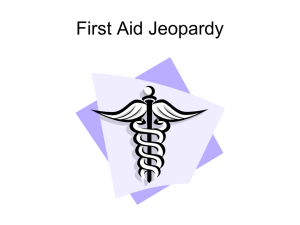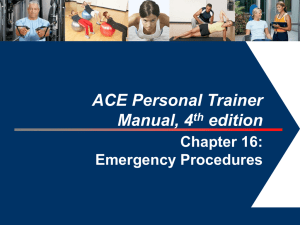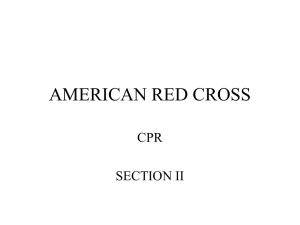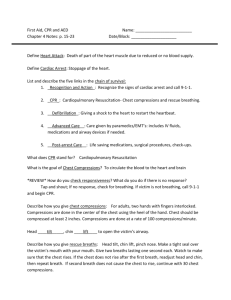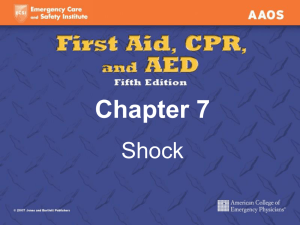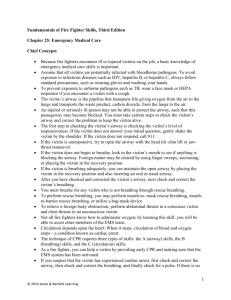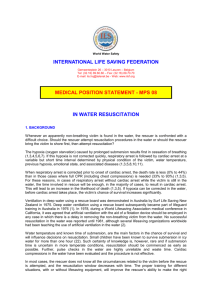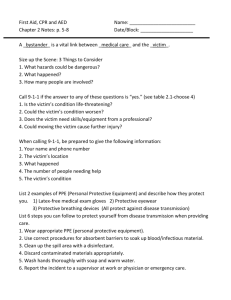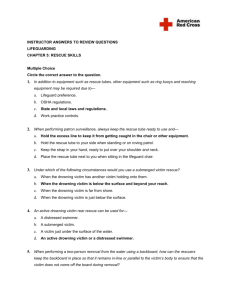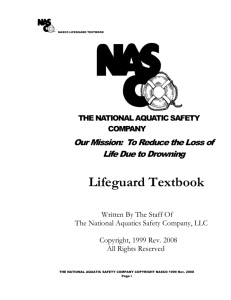Lifeguard Study Guide
advertisement
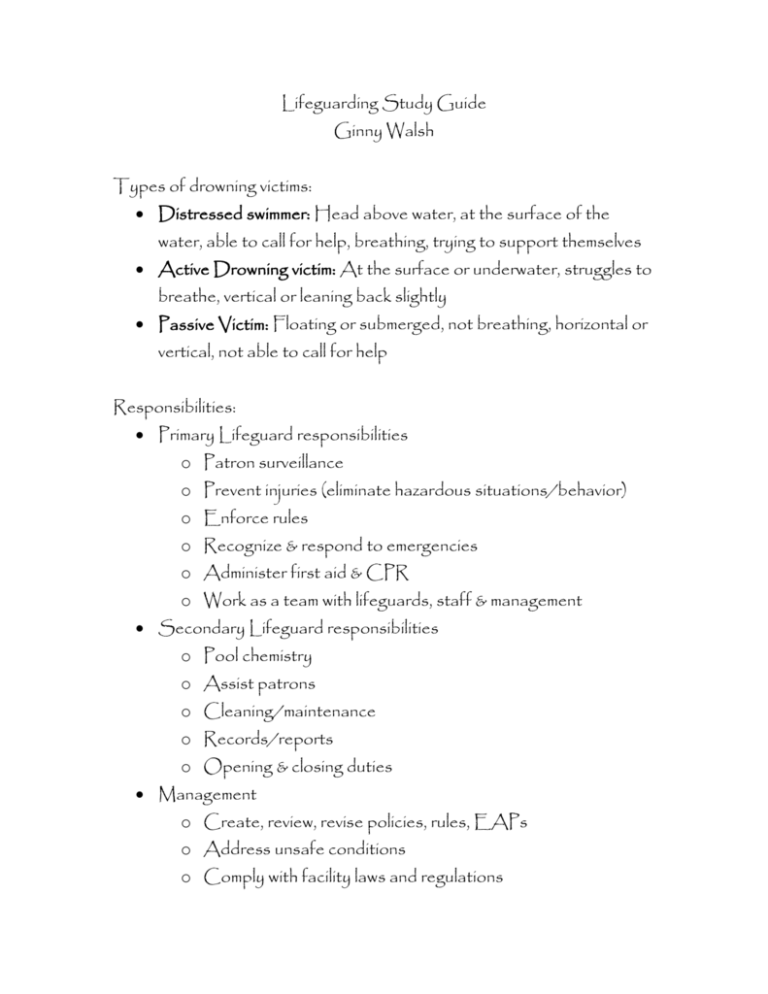
Lifeguarding Study Guide Ginny Walsh Types of drowning victims: Distressed swimmer: Head above water, at the surface of the water, able to call for help, breathing, trying to support themselves Active Drowning victim: At the surface or underwater, struggles to breathe, vertical or leaning back slightly Passive Victim: Floating or submerged, not breathing, horizontal or vertical, not able to call for help Responsibilities: Primary Lifeguard responsibilities o Patron surveillance o Prevent injuries (eliminate hazardous situations/behavior) o Enforce rules o Recognize & respond to emergencies o Administer first aid & CPR o Work as a team with lifeguards, staff & management Secondary Lifeguard responsibilities o Pool chemistry o Assist patrons o Cleaning/maintenance o Records/reports o Opening & closing duties Management o Create, review, revise policies, rules, EAPs o Address unsafe conditions o Comply with facility laws and regulations o Maintain records on the facility & employees o Assist after an emergency Effective scanning: Move your head and eyes while scanning and look directly at each area Stay focused and alert with active posture Scan the surface, middle, and bottom of the pool If you cannot see because of a glare, adjust your position slightly to remove the glare spot Types of coverage: Zone coverage: swimming area is divided into separate zones, one for each lifeguard station Total coverage: you are the only lifeguard conducting patron surveillance when you’re on duty Emergency back up coverage: when one lifeguard enters the water for a rescue, the other lifeguards on during must now watch a larger area Help ensure safe group visits to the pool by: Know who the group chaperones are Having an appropriate number of lifeguards Ensure that patrons stay in the areas of the pool that are right for their swimming level Legal considerations: Good Samaritan Law: Protects people who have provided emergency care in good faith without having accepted anything in return (ie when you aren’t working) Negligence: When a person is injured because lifeguards failed to follow the standard or care or failed to act Failing to control or stop behaviors that could cause injury Failing to provide care Providing inappropriate care Providing care beyond their level of training Spinal Injuries Causes: o Entering the water head-first in shallow water o Receiving a blow to the head o Colliding with another swimmer Signs & symptoms o Bumps or bruises on the head, neck, back o Heavy bleeding of the head, neck, back (including ears and nose) o Seizures, changes in consciousness, nausea or vomiting o Impaired breathing, loss of balance, headache Care you provide: o Depends on the victims condition, location, availability of additional lifeguards o Non-standing victim: support head in the position it was found until EMS gets there o Standing victim: secure the victim to a backboard o For a victim on land, do not move the victim unless the scene becomes unsafe Head-splint technique: provides proper manual in-line stabilization (helps minimize movement of the head and neck) Head and chin support When backboarding, secure the straps in this order: upper chest, hips, thighs Abbreviations: AED: Automated External Defibrillator AFR: Accidental fecal releases o Require water treatment and temporary pool closure EAP: Emergency action plan MSDS: Material safety data sheets o Contains information about what type of chemicals are in use at the facility When do you use the HAINES recovery position? If you must leave a victim alone to get help or if that is the only way to keep the airway clear of vomit What pieces of equipment should be easily accessible for emergency use? Backboard, AED, gloves, resuscitation mask, and rescue tube Steps for spinal injuries: Activate EAP Enter water (slide-in entry) Perform a rescue Check for consciousness & breathing o If breathing, backboard the victim o If victim is not breathing, remove quickly and provide care Steps for water rescues: 1. Activate EAP 2. Enter water and preform appropriate rescue 3. Remove victim from the water 4. Provide emergency care as needed First Aid, AED, CPR Study Guide Abbreviations: PPE: Personal protective equipment o Disposable gloves & breathing barrier o Use them to protect yourself from bloodborne pathogen transmission BVM: Bag Valve Mask SAMPLE: Secondary Assessment * Signs and Symptoms * Allergies * Medications * Past pertinent medical history * Last oral intake * Events leading up to the incident RICE: Rest, immobilize, cold, elevate LOC: Level of Consciousness Need: Care for asthma/difficulty breathing Size up the scene: Use your senses to check for hazards Determine what caused the injury or illness Determine number of injured Determine what additional help is needed Put on appropriate PPE Steps to providing care: 1. Size up scene 2. Obtain consent from the victim or the victim’s parents 3. Perform primary assessment a. Check for responsiveness (if none—call EMS) b. Open the airway and look, listen and feel for breathing and a pulse c. Quickly scan for severe bleeding d. Provide care as needed 4. Perform secondary assessment a. Identify and care for conditions that are not life threatening Summon EMS when: You know someone is having a heart attack A bone is protruding Unconscious victim What type of care to give: Burns o First remove victim from the source of the burn Seizure in water o Support victim with head above water until seizure ends Severe bleeding o Press firmly against the wound with a sterile dressing Conscious choking o Give 5 back blows & 5 abdominal thrusts Adult/child: Place fist in the middle of the abdomen, just above the navel Infant: when giving back blows, position the infant so the head is lower than the chest No Breathing, but has pulse (also if infrequent gasps) = rescue breathing (ventilations) o Adult 1 rescue breath about every 5 sec o Child/Infant 1 rescue breath every 3 sec o If have 2 rescuers—use BVM (Bag Valve Mask) No breathing, no pulse (cardiac arrest) = CPR o Allow chest to fully recoil between compressions o Compress at a rate of 100 compressions per minute o Place victim on a hard, flat surface o Adult Compress the chest at least 2 inches o Infant 2 rescuer: 15 compressions and 2 ventilations one hand on forehead, 2 or 3 fingers in the center of the chest Cardiac Chain of Survival 1. Early recognition & early access to the EMS system 2. Early CPR 3. Early defibrillation 4. Early advanced medical care Using the AED 1. Turn on AED and follow prompts 2. Wipe victims chest dry 3. Attach AED pads to victim’s bare, dry chest a. One on upper right, other lower left i. If don’t fit for infant or child, place one in the middle of the chest and the other on the back ii. If they have jewelry, avoid the jewelry or remove 4. Plug in connector 5. Follow prompts a. When advises a shock, tell everyone to stand clear Giving ventilations 1. Position the mask 2. Open the airway 3. Begin giving ventilations Unconscious chocking 1. Lower victim to the ground and open the airway 2. Retilt head and try ventilations 3. Give 30 chest compressions 4. Look for an object inside the mouth (if you see something, sweep it out) 5. Give 2 ventilations Sudden Illness Symptoms Nausea, vomiting, bruising or rigidness of the abdomen, changes in skin condition



